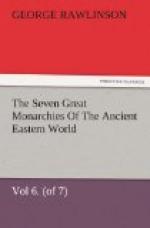Armenia first comes before us in Genesis, where it is mentioned as the country on whose mountains the ark rested. A recollection of it was thenceforth retained in the semi-mythic traditions of the Babylonians. According to some, the Egyptian monarchs of the eighteenth and nineteenth dynasties carried their arms into its remote valleys, and exacted tribute from the petty chiefs who then ruled there. At any rate, it is certain that from about the ninth century B.C. it was well known to the Assyrians, who were engaged from that time till about B.C. 640 in almost constant wars with its inhabitants. At this period three principal races inhabited the country—the Nairi, who were spread from the mountains west of Lake Van along both sides of the Tigris to Bir on the Euphrates, and even further; the Urarda (Alarodii, or people of Ararat), who dwelt north and east of the Nairi, on the upper Euphrates, about the lake of Van, and probably on the Araxes; and the Minni, whose country lay south-east of the Urarda, in the Urumiyeh basin and the adjoining parts of Zagros. Of these three races, the Urarda were the most powerful, and it was with them that the Assyrians waged their most bloody wars. The capital city of the Urarda was Van, on the eastern shores of the lake; and here it was that their kings set up the most remarkable of their inscriptions. Six monarchs, who apparently all belong to one dynasty, left inscriptions in this locality commemorative of their military expeditions or of their offerings to the gods. The later names of the series can be identified with those of kings who contended with Assyrian monarchs belonging to the last, or Sargonid dynasty; and hence we are entitled approximately to fix the series to the seventh and eighth centuries before our era. The Urarda must at this time have exercised a dominion over almost the whole of the region to which the name of Armenia commonly attaches. They were worthy antagonists of the Assyrians, and, though occasionally worsted in fight, maintained their independence, at any rate, till the time of Asshur-bani-pal (about B.C. 640), when the last king of the Van series, whose name is read as Bilat-duri, succumbed to the Assyrian power, and consented to pay a tribute for his dominions.
There is reason to believe that between the time when we obtain this view of the primitive Armenian peoples and that at which we next have any exact knowledge of the condition of the country—the time of the Persian monarchy—a great revolution had taken place in the region. The Nairi, Urarda, and Minni were Turanian, or, at any rate, non-Arian, races. Their congeners in Western Asia were the early Babylonians and the Susianians, not the Medes, the Persians, or the Phrygians. But by the time of Herodotus the Arian character of the Armenians had become established. Their close connection with the Phrygians was recognized. They had changed their national appellation; for while in the Assyrian period the terms Nairi and Urarda had preponderated,




